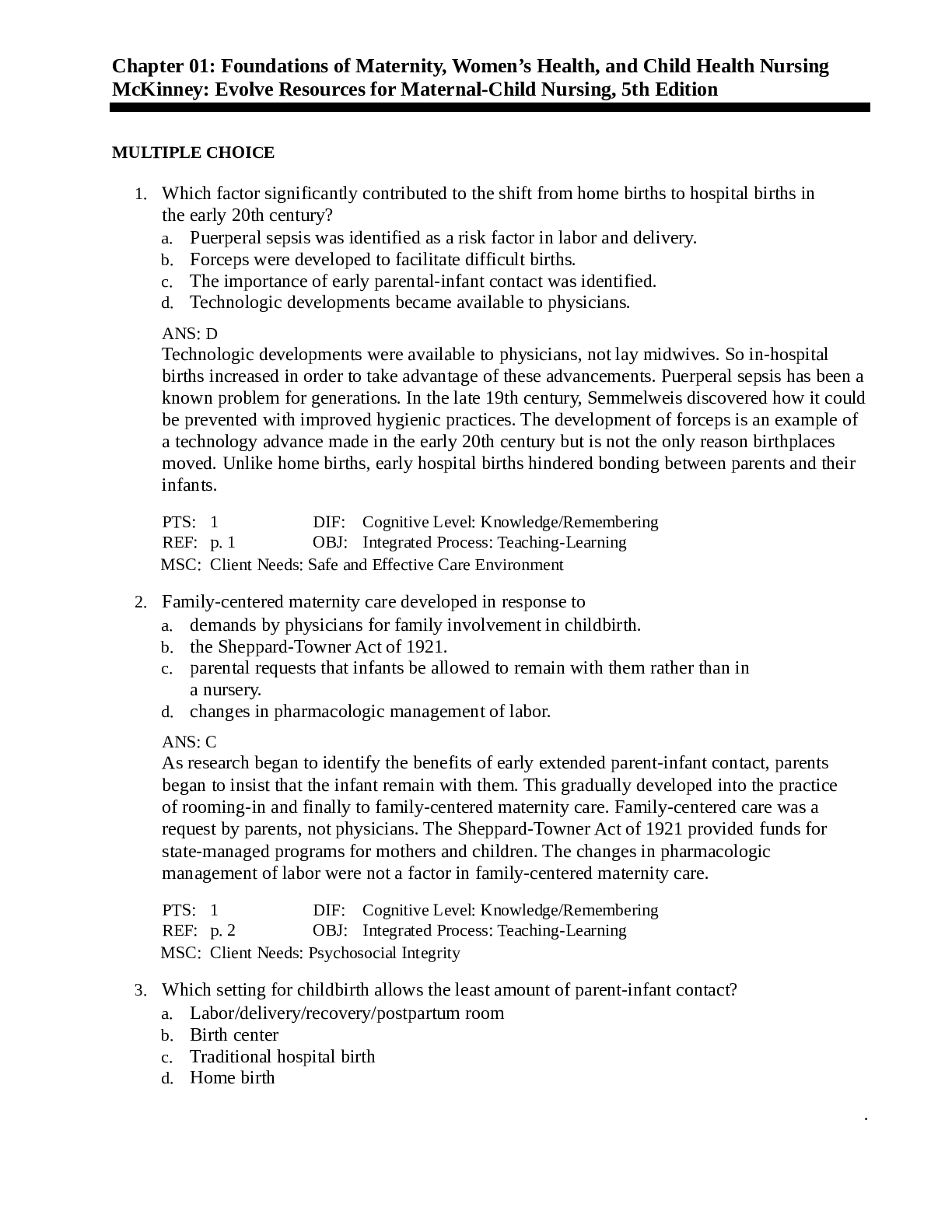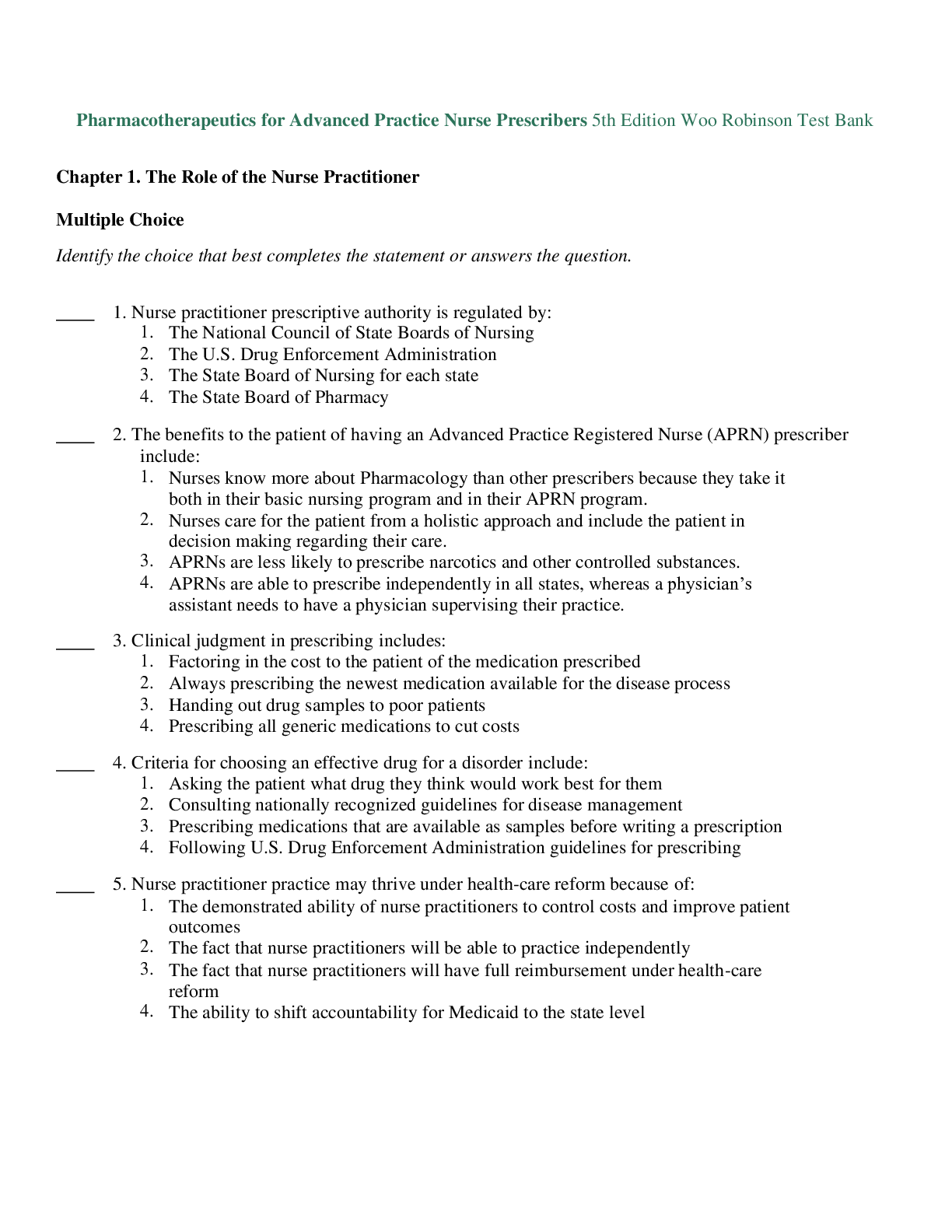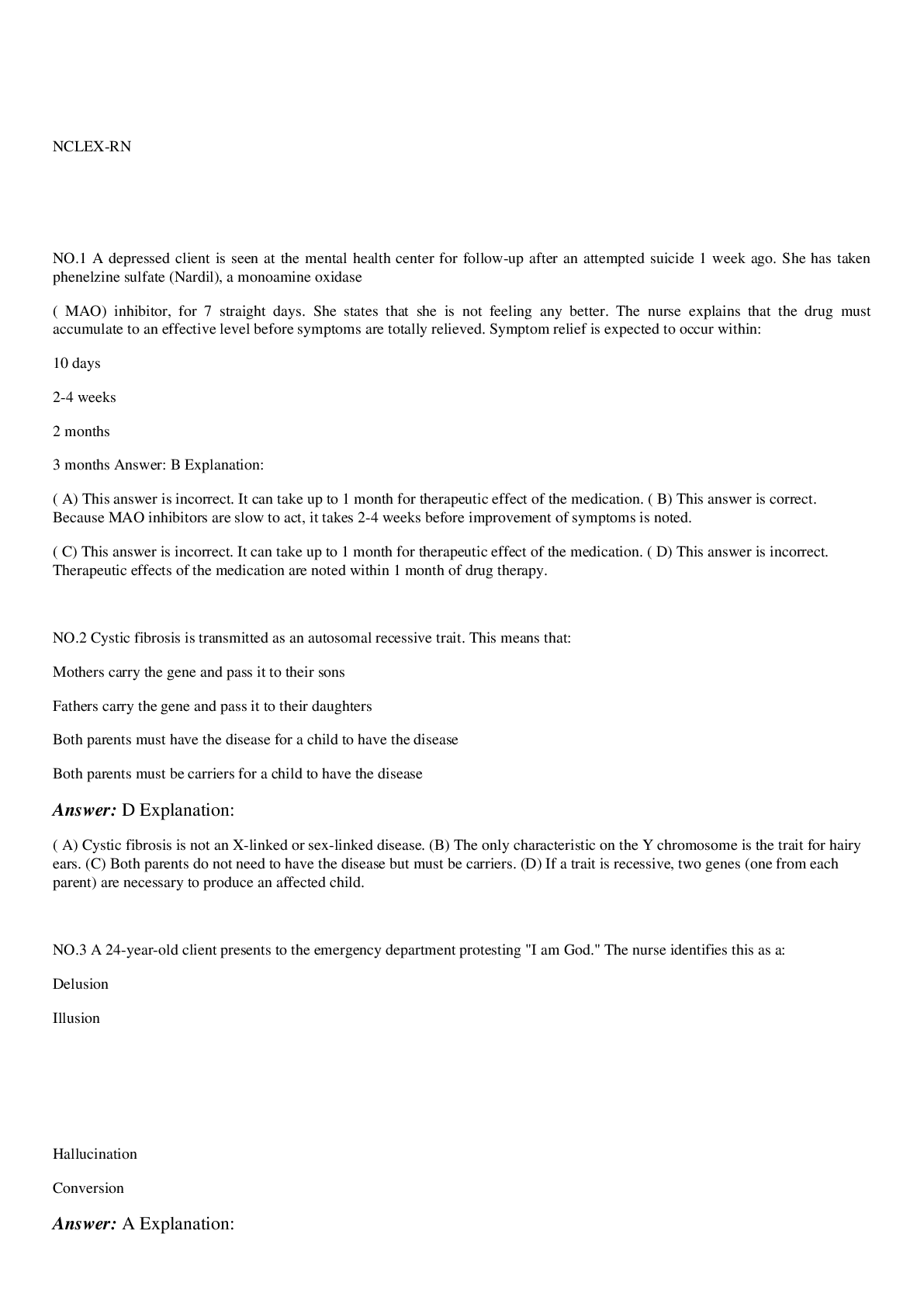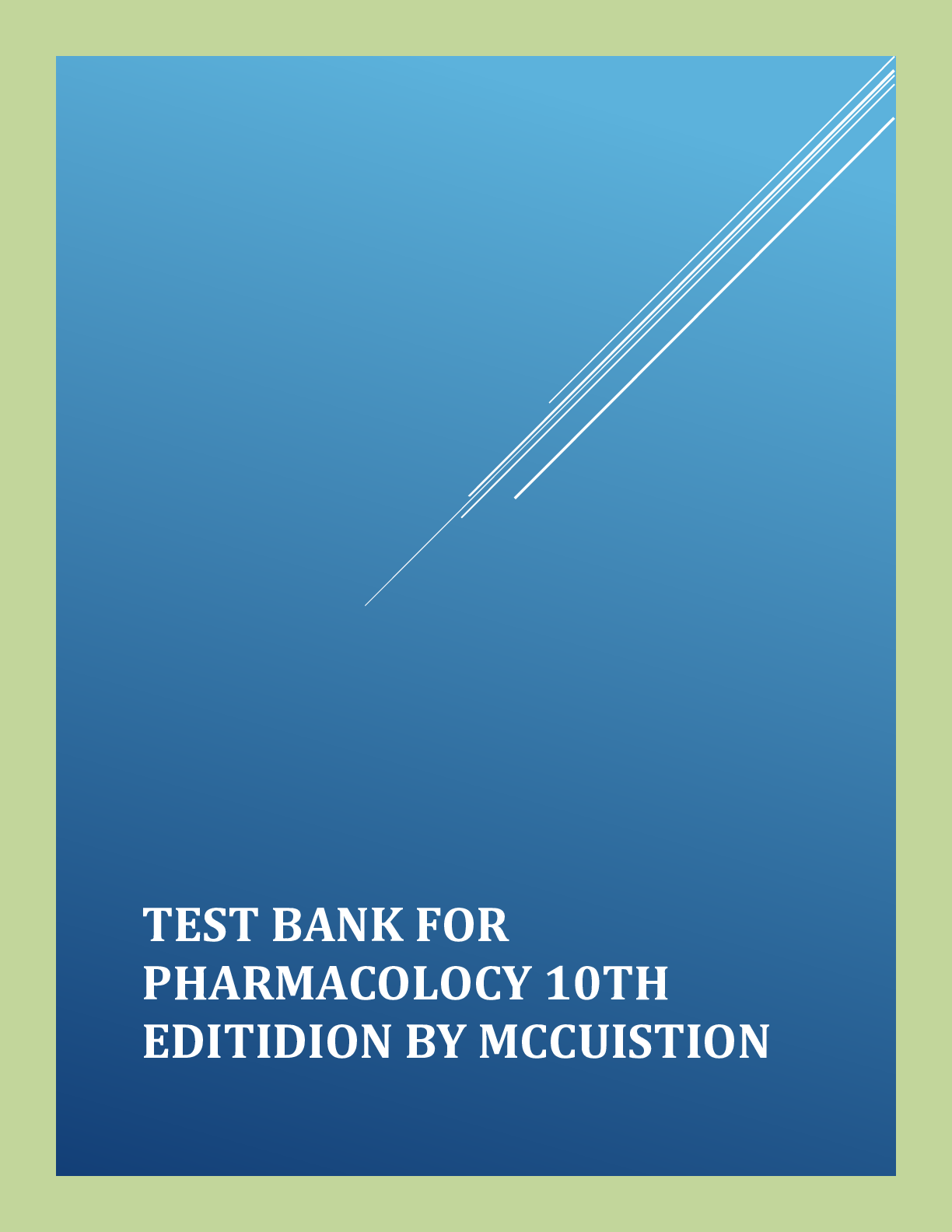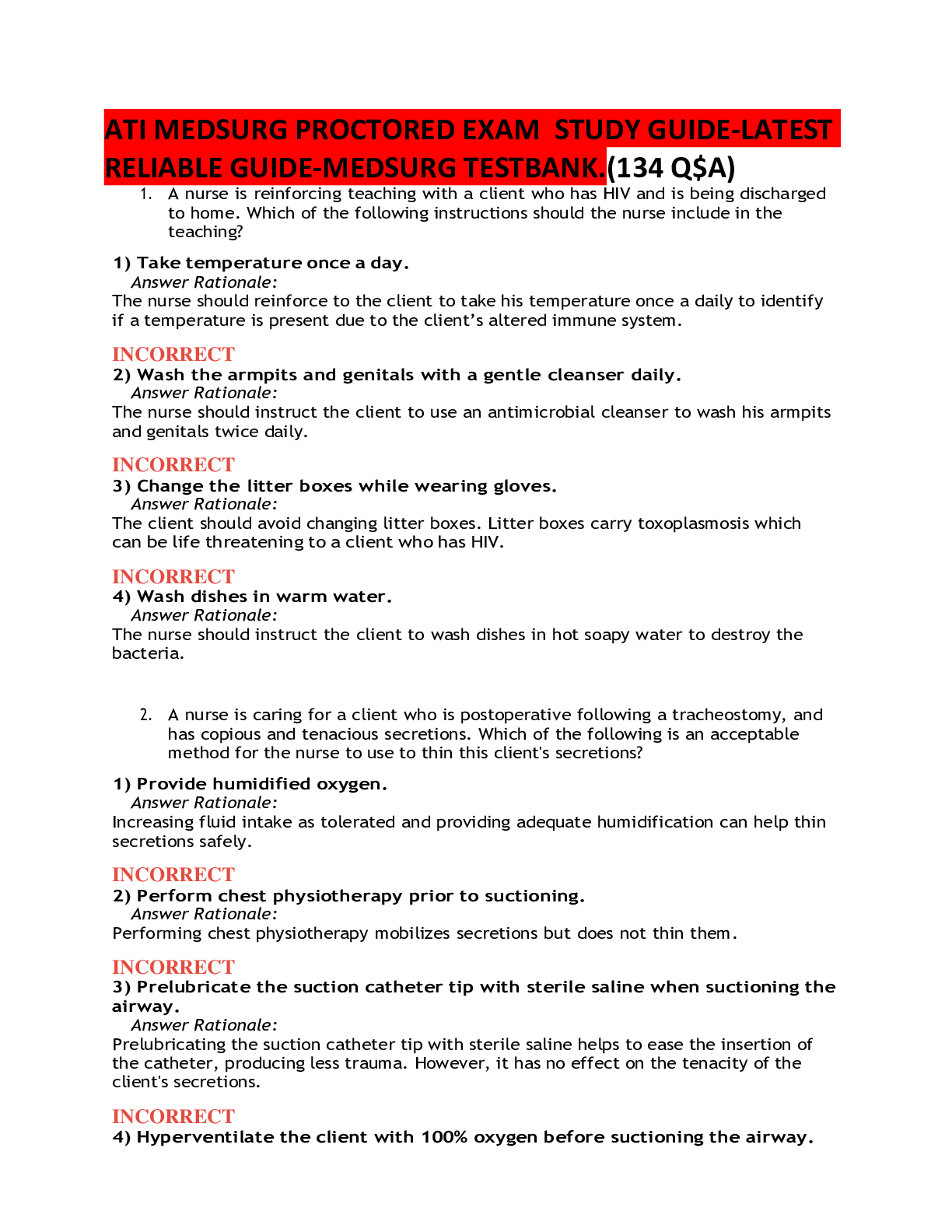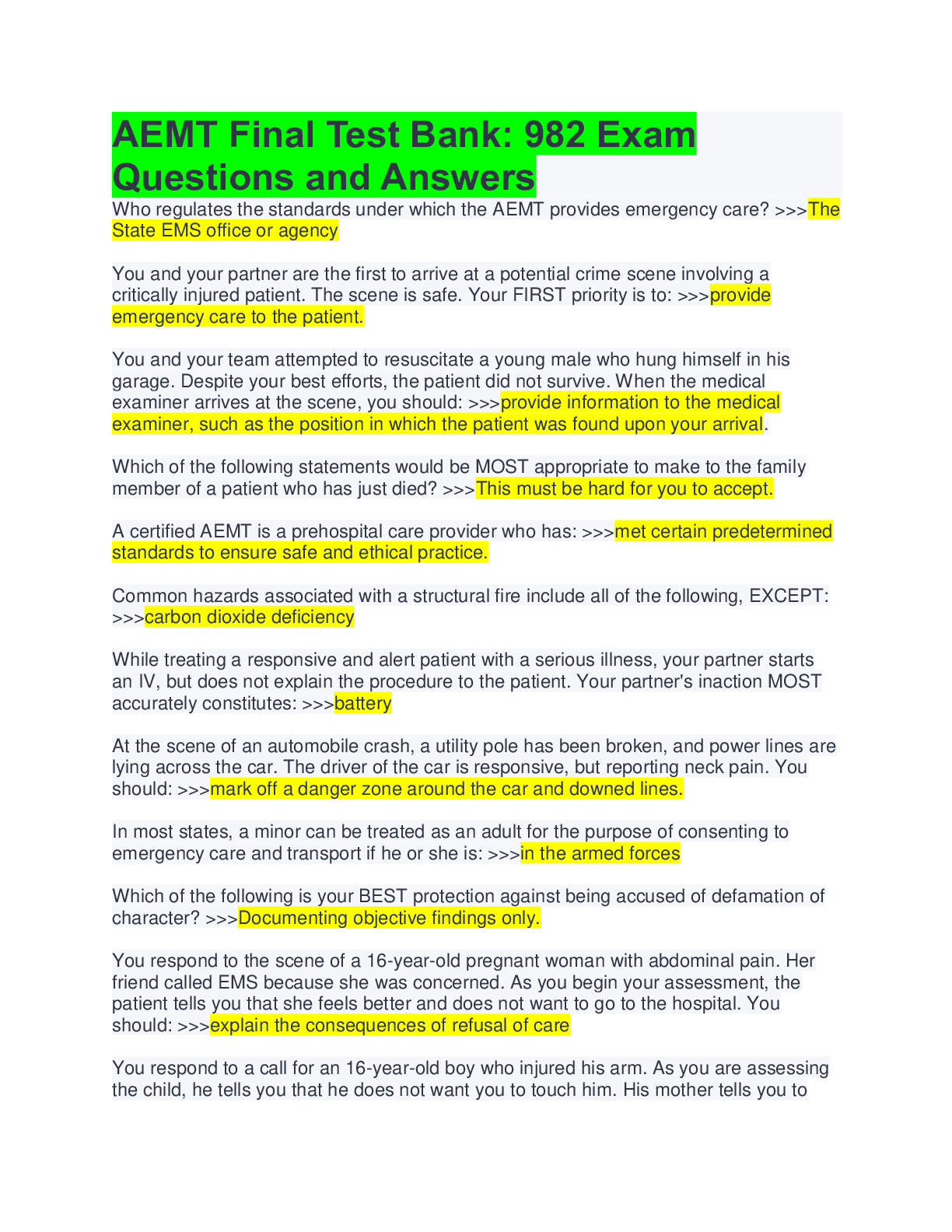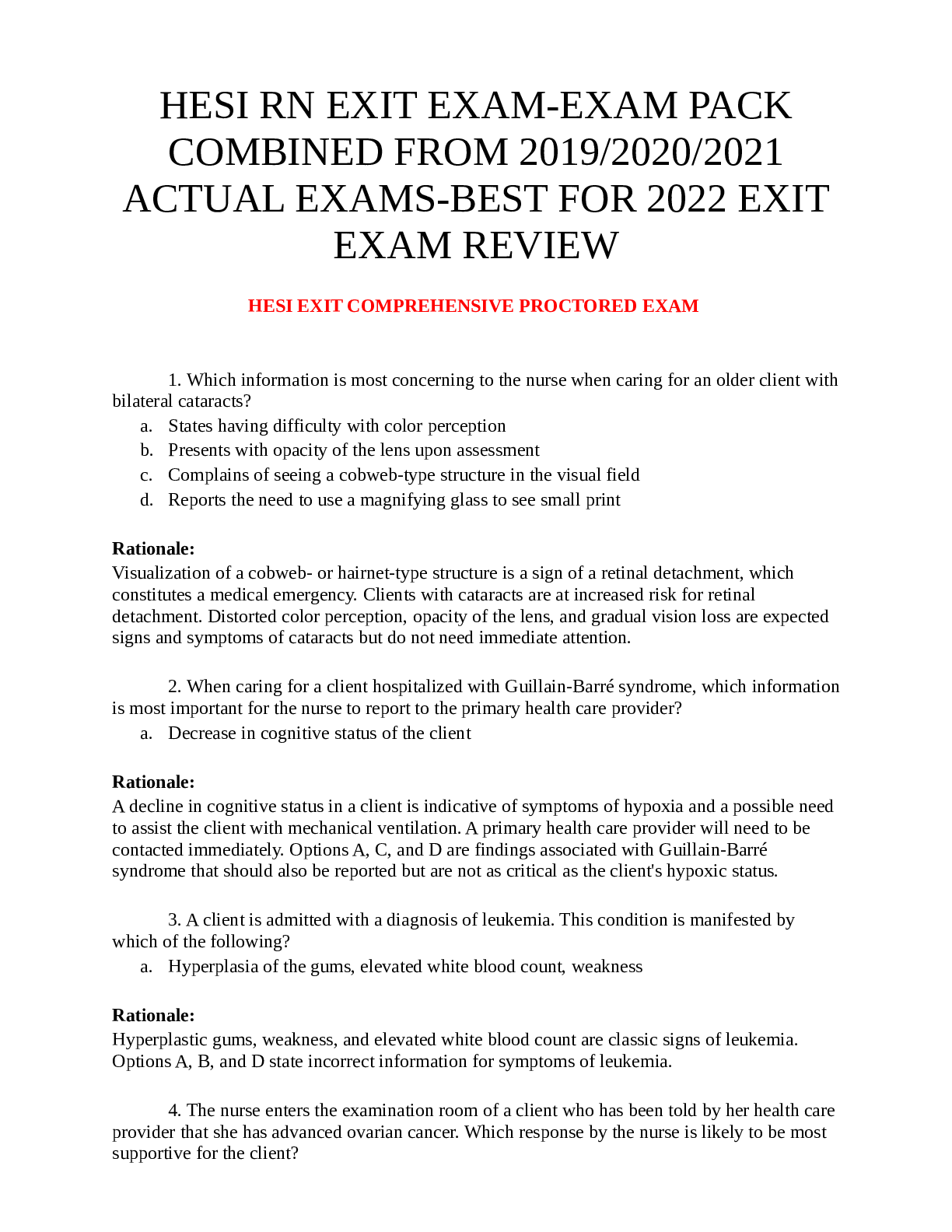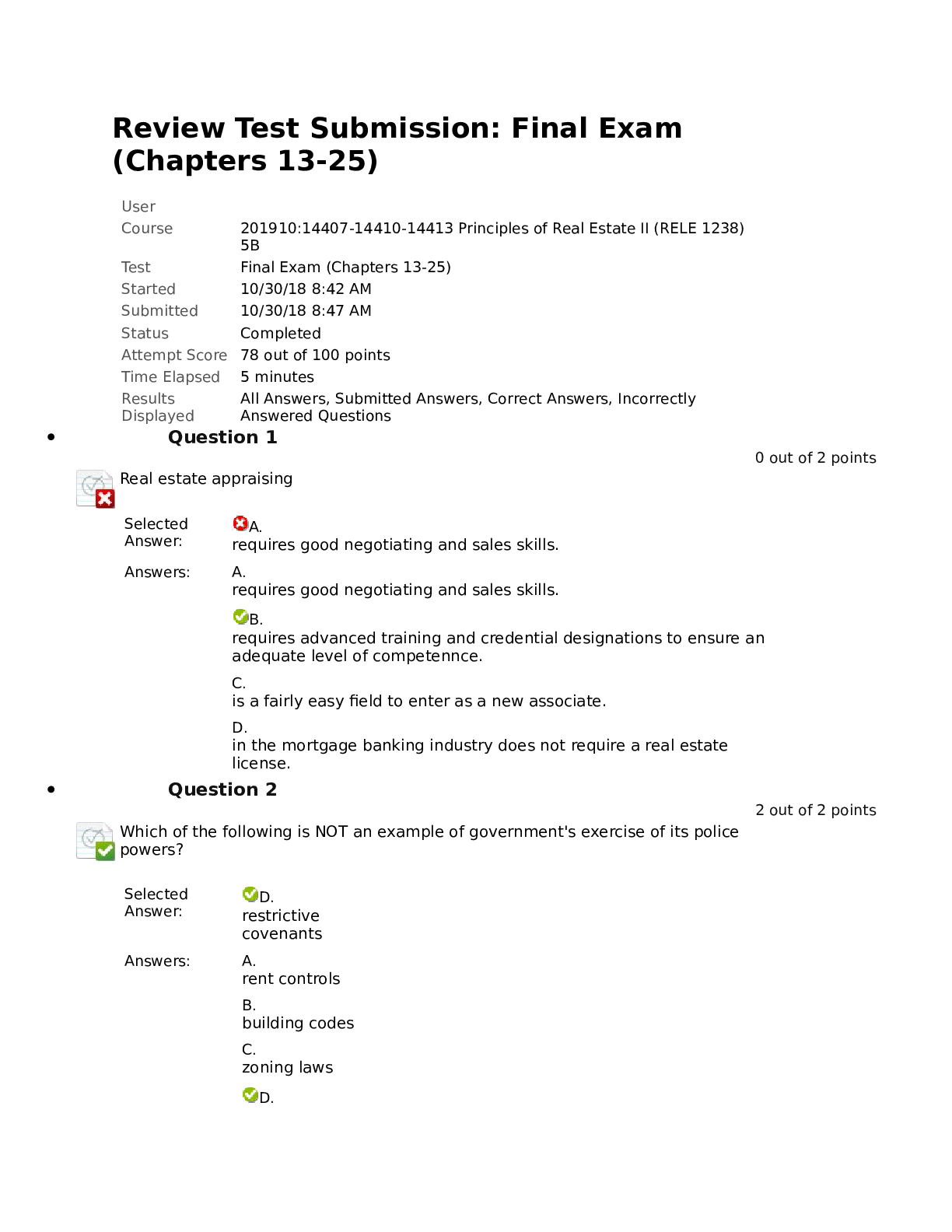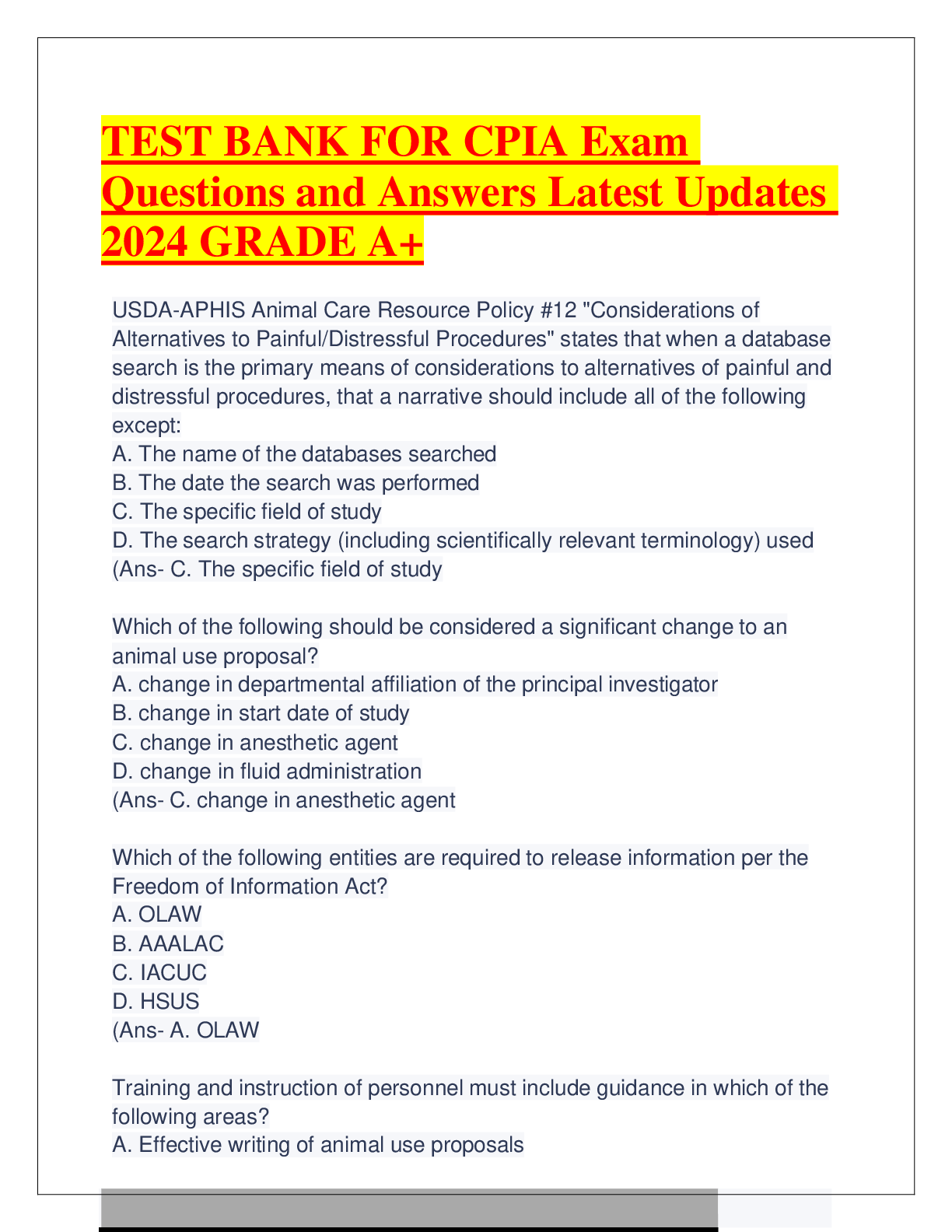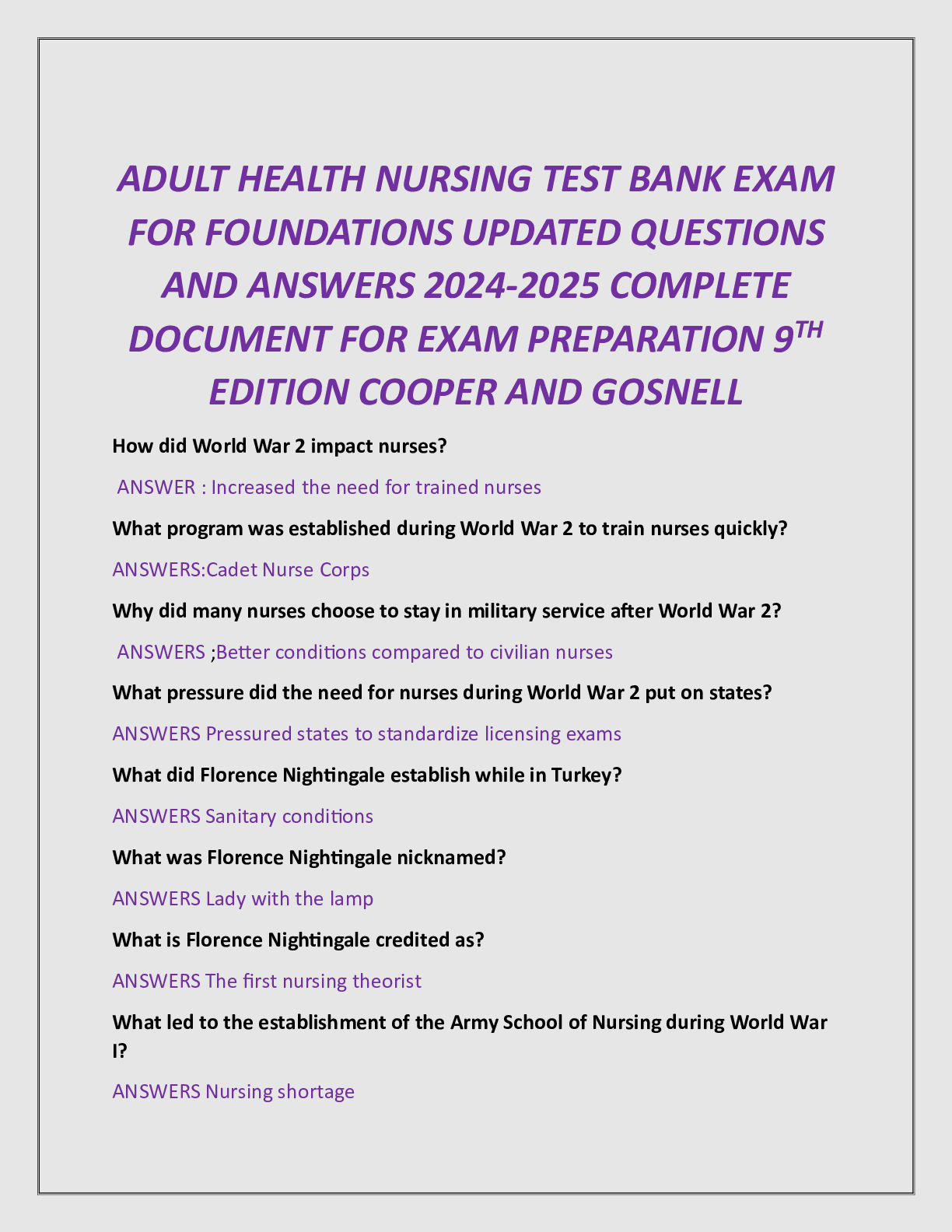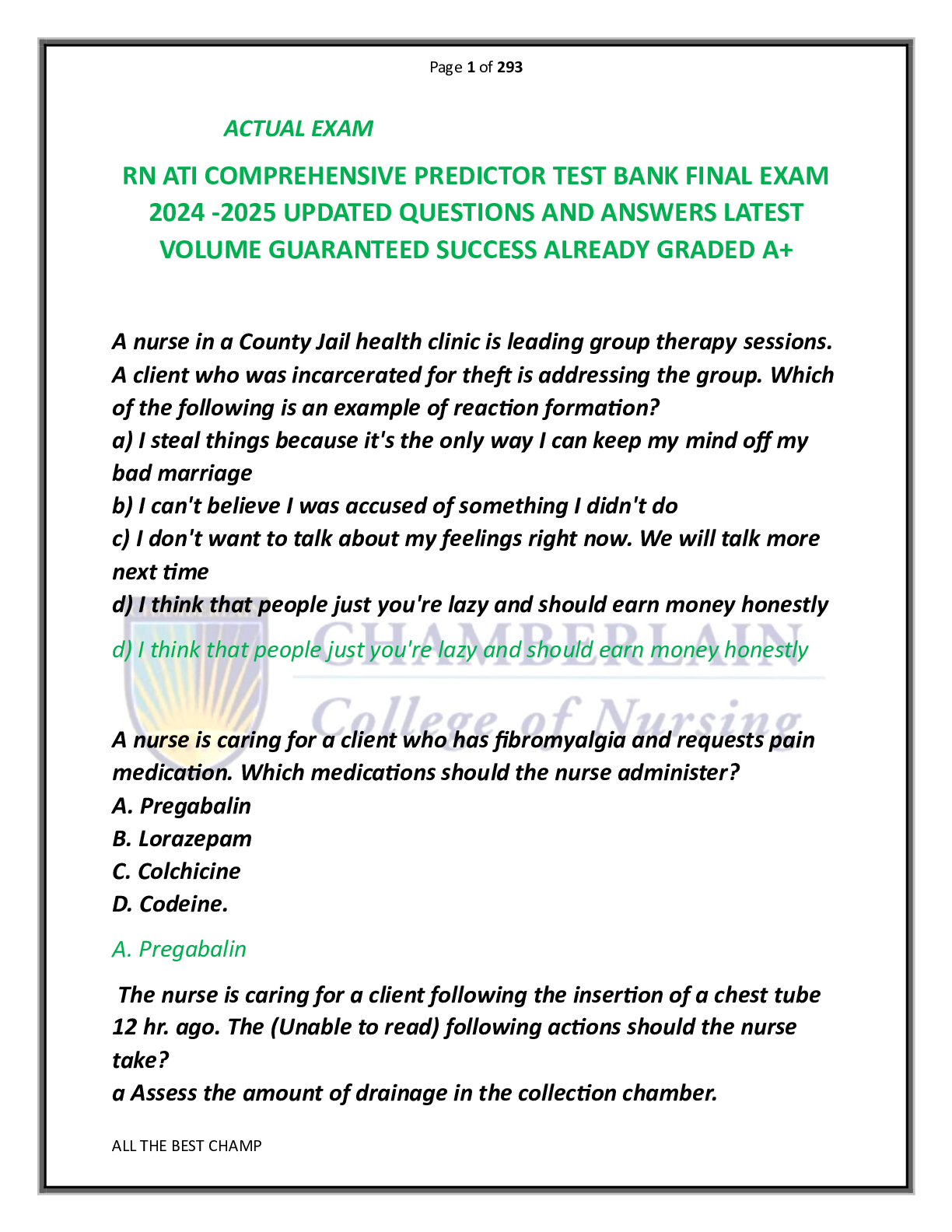*NURSING > TEST BANKS > HESI Comprehensive Exam _ questions /answers, all correct; rated A+ by expert tutors. (All)
HESI Comprehensive Exam _ questions /answers, all correct; rated A+ by expert tutors.
Document Content and Description Below
HESI Comprehensive Exam 2020 133- Cyclobenzaprine (Flexeril) is prescribed to a client with multiple sclerosis for the treatment of muscle spasms. For which common side effect of this medication doe... s the nurse monitor the client? A. Diarrhea B. Drowsiness C. Abdominal pain D. Increased salivation 134 - A nurse administers nitroglycerin sublingually to a client with angina pectoris who complains of chest pain. The medication is ineffective, so the nurse prepares to administer a second dose. Before administering the nitroglycerin, which action does the nurse make a priority? A. Checking the client's blood pressure B. Obtaining blood levels of cardiac enzymes C. Asking the client whether he has a headache D. Obtaining a 12-lead electrocardiogram (ECG) 135- Ciprofloxacin hydrochloride (Cipro) is prescribed to a client with a urinary tract infection. The nurse, providing instruction about the medication, tells the client that it is best to take the medication: A. With milk B. With an antacid C. 2 hours after meals D. With aluminum hydroxide 136.- A nurse provides home care instructions to a client with coronary artery disease (CAD) who is being discharged from the hospital. Which statement by the client indicates a need for further instruction? A. "I need to carry my nitroglycerin with me at all times." B. "I need to check my pulse before, during, and after exercise." C. "I need to avoid foods with saturated fats and foods high in cholesterol." D. "I need to participate in aerobic and weightlifting exercise three times a week." 137- A nurse provides information to a client who will be undergoing endoscopic retrograde cholangiopancreatography (ERCP). The nurse tells the client that: A. There is no need to fast (NPO status) before the procedure B. The gallbladder is easily removed during this procedure if gallstones are found C. The procedure is performed specifically to visualize the esophagus, stomach, and duodenum D. Dye may be injected during the procedure to permit visualization of the pancreatic and biliary ducts 138.ID: 383713175 A client who has undergone knee-replacement surgery will be self-administering enoxaparin sodium (Lovenox) at home. The nurse teaches the client about the medication and tells the client to: A. Store the medication in the refrigerator B. Lie down to administer the subcutaneous injection C. Inject the medication in the upper outer aspect of the arm D. Discard the medication if the solution appears pale yellow 139.ID: 383703667 An intravenous dose of adenosine (Adenocard) is prescribed for a client to treat Wolff-ParkinsonWhite syndrome. Which piece of equipment does the nurse make a priority of obtaining before administering the medication? A. Pulse oximeter B. Cardiac monitor C. Blood-pressure cuff D. Suction catheter and suction machine 140.ID: 383703619 A nurse provides information to a client with coronary artery disease (CAD) about smoking-cessation measures. Which statement by the client indicates a need for further information? A. "A community support group will help me quit." B. "I should drink a cup of coffee if I feel the urge to smoke." C. "Relaxation exercises will help control my urge to smoke." D. "I can try chewing gum or sucking on hard candy if I feel the urge to smoke." 141.ID: 383708584 Captopril (Capoten) is prescribed for a hospitalized client with heart failure. Which action is a priority once the nurse has administered the first dose? A. Checking the client's apical heart rate B. Maintaining the client on bed rest for 3 hours C. Monitoring the client for increased urine output D. Checking the client's breath sounds for decreased wheezing 142.ID: 383706680 A client with heart failure suddenly experiences profound dyspnea, pallor, audible wheezing, and cyanosis, and the nurse suspects pulmonary edema. The nurse would first: A. Obtain a pulse oximetry reading B. Raise the head of the client's bed C. Administer a dose of morphine sulfate D. Obtain a specimen for an arterial blood gas determination 143.ID: 383703665 The nurse administers intravenous morphine sulfate to a client in pulmonary edema. For which intended effect of the medication does the nurse monitor the client? A. Relief of pain B. Relief of anxiety C. Decreased urine output D. Increased blood pressure 144.ID: 383702944 A nurse is providing home care instructions to a client with coronary artery disease (CAD) who will be discharged home and will be taking 1 aspirin daily. The nurse tells the client: A. To stop the aspirin if nausea occurs In B. To take the aspirin on an empty stomach C. That the aspirin is a short-term treatment and will probably be discontinued in 2 weeks 145.ID: 383713112 A client receiving parenteral nutrition (PN) suddenly experiences chest pain and dyspnea, and the nurse suspects an air embolism. The nurse immediately places the client in a lateral Trendelenburg position, on the left side. What action does the nurse take next? A. Auscultating heart sounds B. Clamping the intravenous catheter C. Checking the client's blood pressure D. Obtaining an arterial blood gas specimen 146.ID: 383711448 A nurse is teaching a client with left-side weakness how to walk with the use of a quad-cane. The nurse ensures that: A. The client places the cane on the left side B. The top of the cane is level with the client's waist C. 30-degree flexion of the client's elbow is maintained when the client is holding the cane D. The client leans on the cane and places as much weight as possible on the cane when moving it forward 147.ID: 383702961 A nurse is preparing the room of a client in skeletal traction who will be admitted to the nursing unit. Which item for use by the client does the nurse identify as the most important? A. Telephone B. Television C. Trapeze bar D. Bedside commode 148.ID: 383702975 A nurse taking the vital signs of a client immediately after she has delivered a newborn notes that the client's heart rate is 110 beats/min. The nurse would first: A. Document the findings B. Offer the client oral fluids C. Recheck the heart rate in 1 hour D. Check the uterus and amount of lochia discharge 149.ID: 383708504 A client is receiving an intravenous infusion of alteplase (tissue plasminogen activator, recombinant; tPA). For which adverse effect of the medication does the nurse monitor the client most closely? A. Bleeding B. Hearing loss C. Decreased urine output D. Increased blood pressure 150.ID: 383708596 View video. The nurse is performing a sterile change of an abdominal dressing. Once the dressing has been removed and discarded in a waterproof bag, which action should the nurse take next? A. Assessing the wound B. Donning sterile gloves C. Cleansing the wound D. Setting up the sterile field 151.ID: 383706038 A nurse is providing morning care to a client who has undergone surgery to repair a fractured left hip. Which item is most important for the nurse to use in turning the client from side to side to change the bed linens? A. Trapeze bar B. Sliding board C. Adduction device D. Abduction device Correc 152.ID: 383710526 A nurse provides dietary instructions to a client with osteoporosis who has sustained a fracture about foods that will promote healing. The nurse tells the client that it is best to consume foods that are high in: A. Fats B. Vitamin C C. Carbohydrates D. Concentrated sugar 153.ID: 383710520 A nurse in a physician's office is talking to a client who underwent mastectomy of the right breast 2 weeks ago. The client says to the nurse, "I hate looking at this incision. I feel that I'm not even myself anymore." The nurse interprets this statement to mean that the client is experiencing which problem? A. Inability to cope B. Distorted body image C. Inability to care for self D. Inability to maintain health 154.ID: 383703639 A nurse discovers that a client receiving heparin sodium by way of continuous intravenous (IV) infusion has removed the IV tubing from the infusion pump to change his hospital gown. After assessing the client and placing the tubing back in the infusion pump, which medication does the nurse check for in the medication room in case a heparin overdose has occurred? A. Protamine sulfate B. Enoxaparin (Lovenox) C. Phytonadione (vitamin K) D. Aminocaproic acid (Amicar) 155.ID: 383703663 The mother of a newborn found to have a congenital diaphragmatic hernia asks the nurse to explain the diagnosis. The nurse tells the mother that in this condition: A. The esophagus terminates before it reaches the stomach B. Gastric contents are regurgitated back into the esophagus C. Abdominal contents herniate through an opening of the diaphragm D. A portion of the stomach protrudes through the esophageal hiatus of the diaphragm 156.ID: 383710522 A nurse is performing an assessment of a newborn with a diagnosis of esophageal atresia (EA) and tracheoesophageal fistula (TEF). Which findings does the nurse expect to note in the infant? Select all that apply. A. Drooling B. Wheezing C. Hiccuping D. Short periods of apnea E. Excessive oral secretions F. Bowel sounds over the chest 157.ID: 383711493 A nurse is reviewing the medical record of an infant in whom hypertrophic pyloric stenosis (HPS) is suspected. Which characteristics associated with the disorder does the nurse expects see documented in the infant’s medical record? Select all that apply. A. Weight loss B. Facial edema C. Metabolic acidosis D. Projectile vomiting E. Distended upper abdomen 158.ID: 383703641 A client with a history of angina pectoris tells the nurse that the chest pain usually occurs with moderate to prolonged exertion and is generally relieved by nitroglycerin or rest. Which type of angina does the nurse recognize in the client’s description? A. Stable B. Variant C. Unstable D. Crescendo 159.ID: 383706082 Methylergonovine (Methergine) is prescribed for a client to control postpartum bleeding. Which action does the nurse take before administering the medication? A. Checking the episiotomy site B. Palpating the client's bladder C. Checking the client's blood pressure D. Ensuring that the uterus is contracted 160.ID: 383706068 A nurse is teaching a client with angina pectoris who is being discharged from the hospital about managing chest pain at home. Which statement by the client indicates a need for further teaching? A. "I need to keep fresh nitroglycerin available in case I need it." B. "I need to check the expiration date on the nitroglycerin bottle." C. "If I have any chest pain, I need to stop what I am doing and sit or lie down." D. "If I get chest pain, I should put 3 nitroglycerin tablets under my tongue and then go to the emergency department if that doesn’t work." 161.ID: 383707949 A nurse develops a list of home care instructions for a client who is wearing a halo fixation device after sustaining a cervical fracture. Which instructions should the nurse include? Select all that apply. A. Use a straw to drink. B. Avoid sexual activity while the vest is in place. C. Apply powder under the vest to prevent irritation. D. Use caution when leaning forward or backward. E. Wear snug clothing to prevent the device from shifting. F. Do not drive, because full range of vision is impaired with the device. 162.ID: 383710057 A nurse is assessing a client who is experiencing chest pain. Which of the following observations indicates to the nurse that the pain is most likely a result of angina? A. The pain is relieved by rest and nitroglycerin. B. The pain is relieved by the administration of an antacid. C. The pain is relieved by the administration of an antiinflammatory medication. D. The pain is relieved with an upright sitting position and the administration of an analgesic. 163.ID: 383706640 A nurse has provided nutrition instructions to a mother of an infant. Which statement by the mother indicates to the nurse that the mother requires further instruction? A. "It’s best to use cow's milk, as long as it’s whole milk and not skim." B. "When I start feeding solid foods, I might need to add water to the food." C. "When the baby starts to take juices, I shouldn’t warm the juice, because that will destroy the vitamin C." D. "The baby will get the right nutrition if I feed breast milk or store-bought formula that’s been fortified with iron.” 164.ID: 383703671 A pediatric nurse is caring for a hospitalized toddler. Which of the following activities does the nurse deem the most appropriate for the toddler? A. Singing games B. Watching videos C. Simple board games D. Large building blocks 165.ID: 383709206 A nurse in a physician's office is reviewing the medical record of a child with a diagnosis of lactose intolerance. Which of the following findings does the nurse expect to see documented in the child's record? A. Fatty stools B. Episodes of foul-smelling ribbonlike stools C. Episodes of profuse watery diarrhea and vomiting D. Episodes of cramping abdominal pain and excessive flatus 166.ID: 383712470 A nurse is providing dietary instructions to the mother of a child with celiac disease. The nurse tells the mother that it is acceptable to give the child: A. Boiled rice B. Cooked pasta C. Warm oatmeal D. Baked macaroni and cheese 167.ID: 383713110 A nurse admitting a newborn to the nursery notes that the physician has documented that the newborn has a gastroschisis. The nurse performs an assessment, expecting to note that the viscera are: A. Inside the abdominal cavity and under the skin B. Inside the abdominal cavity and under the dermis C. Outside the abdominal cavity, not covered with a sac D. Outside the abdominal cavity but inside a translucent sac covered with peritoneum and amniotic membrane 168.ID: 383707998 A nurse is monitoring a child with intussusception for signs of peritonitis. For which of the following findings, indicative of this complication, does the nurse notify the physician? A. Increased alertness B. Increased heart rate C. A sausage-shaped abdominal mass D. Diarrhea and the passage of bloody mucous stool 169.ID: 383713179 The nurse, auscultating the breath sounds of a client, hears these sounds. What are they? A. Rhonchi B. Crackles C. Wheezes D. Vesicular 170.ID: 383703631 A registered nurse is planning client assisgnments for the day. There is a licensed practical nurse and a nursing assistant on the team. Which client is the appropriate choice for the nursing assistant? A. A client with hemophilia who needs assistance with shaving B. A client with pneumonia who requires frequent oropharyngeal suctioning C. A client with rheumatoid arthritis who needs assistance with feeding and ambulation D. A client with heart failure who needs daily weights and monitoring of intake and output 171.ID: 383706623 A nurse is monitoring a client with bronchogenic carcinoma for signs of superior vena cava syndrome. For which early sign of this oncological emergency does the nurse assess the client? A. Dyspnea B. Cyanosis C. Hypotension D. Stokes sign 172.ID: 383704500 A nurse is caring for a client who has undergone transsphenoidal hypophysectomy to remove a microadenoma of the pituitary gland. Which of these findings would be of greatest concern to the nurse? A. Urinary specific gravity is low B. Blood pressure is 138/80 mm Hg. C. The client complains of a dry mouth. D. The client frequently performs deep-breathing exercises. 173.ID: 383703683 The nurse notes the presence of drainage on the mustache dressing of a client who has undergone transsphenoidal hypophysectomy. The initial nursing action is to: A. Contact the surgeon B. Change the dressing C. Document the findings D. Check the drainage for glucose 174.ID: 383706676 A nurse is monitoring a client who has undergone subtotal thyroidectomy for signs of postoperative complications. Which of the following findings would be a matter of concern for the nurse as an indication of hypocalcemia? A. The client's temperature is 100.6˚ F. B. The client's voice is hoarse and weak. C. The client's heart rate is 92 beats/min. D. The client complains of a tingling sensation around the mouth. 175.ID: 383705065 A nurse is monitoring a client who was brought to the emergency department in an unresponsive state and is now being treated for hyperglycemic hyperosmolar nonketotic syndrome (HHNS). Which of the following findings indicates to the nurse that fluid replacement is inadequate? A. Increased urine output B. Potassium level of 3.6 mEq/L C. Blood pressure of 128/80 mm Hg D. Level of consciousness remains unchanged 176- A nurse is reviewing the laboratory results of a client in the emergency department with diabetic ketoacidosis (DKA). Which laboratory result would the nurse expect to note? A. Creatinine 1.0 mg/dL B. Serum bicarbonate of 12 mEq/L C. Blood urea nitrogen (BUN) of 15 mg/dL D. Negative results on urinary ketone testing 177.ID: 383710513 Propylthiouracil (PTU) has been prescribed for a client with Graves disease, and the nurse provides instructions to the client about the medication. For which of the following occurrences does the nurse tells the client to contact the physician? A. Fatigue B. Diaphoresis C. Sore throat D. Heat intolerance 178.ID: 383709215 A nurse is providing information to a client with diabetes insipidus who will be taking desmopressin acetate (DDAVP) by way of the nasal route. For which of the following occurrences does the nurse tell the client to contact the physician? A. Abdominal cramps B. Stuffy or runny nose C. Headache and nausea 179.ID: 383702948 A client with diabetes mellitus calls the clinic nurse and reports that she has been vomiting during the night and now has diarrhea. Which question does the nurse make a priority of asking the client? A. "Do you have a fever?" B. "Did you eat any breakfast?" C. "Are you urinating frequently?" D. "Have you tested your blood glucose?" 180.ID: 383708540 A nurse is providing information to a client who will be self-administering regular insulin about storage of the insulin. The nurse tells the client: A. That placing the vial near heat or in sunlight will not affect the insulin B. To freeze unopened vials and remove a vial from the freezer 24 hours before opening it C. That insulin stored at room temperature causes more discomfort on injection than does cold insulin D. That the vial in current use may be kept at room temperature for as long as 1 month without significant loss of activity 181.ID: 383704568 A nurse reviews the medical record of a client with histoplasmosis. Which clinical manifestation of this infection does the nurse expect to see documented? A. Neurological deficits B. Cardiac dysrhythmias C. Gastrointestinal disturbances D. Flulike pulmonary symptoms 182.ID: 383704517 A client with a medical history of diabetes mellitus is found to have sarcoidosis, and oral prednisone is prescribed. The nurse provides instructions to the client about the medication and tells the client to: A. Eat foods that are high in sodium B. Decrease the daily dose of insulin C. Eat foods that are low in potassium D. Closely monitor the blood glucose level 183.ID: 383711481 A client with tuberculosis will be taking pyrazinamide (Pyrazinamide), and the nurse provides instructions about the adverse effects of the medication. For which of the following occurrences does the nurse tell the client to contact the physician? A. Headache B. Yellow skin C. Difficulty sleeping D. Nasal congestion 184.ID: 383702946 A client who was involved in a high-speed motor vehicle crash is brought to the emergency department. Which of the following findings indicates to the nurse that the client has sustained flail chest? A. Asymmetrical chest movement B. Complaints of mild chest discomfort C. Increased breath sounds on auscultation D. Deep respirations, 18 breaths/min 185.ID: 383708594 A client is found to have hypoxemic respiratory failure. Which finding does the nurse expect to note on review of the results of the client's arterial blood gas analysis? A. Pao2 of 73 mm Hg, Paco2 of 62 mm Hg B. Pao2 of 58 mm Hg, Paco2 of 35 mm Hg C. Pao2 of 60 mm Hg, Paco2 of 45 mm Hg D. Pao2 of 49 mm Hg, Paco2 of 32 mm Hg 186.ID: 383707958 A client with acute gouty arthritis is being started on medication therapy with indomethacin (Indocin). The nurse, providing medication instructions, and tells the client to take the medication: A. At bedtime B. With food C. 1 hour before meals D. On an empty stomach 187.ID: 383705037 An emergency department nurse is monitoring a client who sustained a severe inhalation burn injury during a fire in which the client was trapped in an enclosed space. The nurse auscultates the client's trachea and notes that the previously heard wheezing sounds have disappeared. The nurse most appropriately: A. Continues monitoring the client B. Notifies the emergency department physician C. Documents the client's improvement in the medical record D. Removes the oxygen mask and fits the client with a nasal cannula 188.ID: 383703645 A nurse reviews arterial blood gas values and notes a pH of 7.50 and a Pco2 of 30 mm Hg. The nurse interprets these values as indicative of: A. Metabolic acidosis B. Metabolic alkalosis C. Respiratory acidosis D. Respiratory alkalosis 189.ID: 383702997 A nurse provides information to a client with chronic obstructive pulmonary disease (COPD) about methods of alleviating shortness of breath while the client is eating. Which statement by the client indicates a need for further instruction? A. "I should rest before I eat." B. "I should use my bronchodilator 30 minutes before I eat." C. "Pursed-lip breathing will help relieve my shortness of breath." D. "I should eat three meals a day, and the biggest meal should be at suppertime." 190.ID: 383712487 A postoperative client with deep-vein thrombosis is at risk for pulmonary embolism. For which characteristic sign or symptom of this complication does the nurse monitor the client? A. Pleuritic chest pain B. Slowed heart rate C. Chills and a high fever D. Decreased respiratory rate 191.ID: 383710589 A nurse caring for a client 24 hours after a radical neck dissection notes the presence of serosanguineous drainage in the portable wound suction device attached to the surgical site. On the basis of this finding, the nurse should: A. Contact the physician B. Document the findings C. Ask the physician to remove the drains D. Increase the pressure on the wound suction devic 192- Although previously well controlled with glyburide (Diabeta), a client’s fasting blood glucose has been running 180 to 200 mg/dL. On reviewing the client's record, which medication, recently added to the client's regimen, does the nurse recognize as a possible contributor to the hyperglycemia? A. Phenelzine (Nardil) B. Atenolol (Tenormin) C. Allopurinol (Zyloprim) D. Lithium carbonate (Lithobid) 193.ID: 383704525 A nurse is performing an assessment of a client with suspected pheochromocytoma. Which clinical manifestation does the nurse expect to note? A. Weight gain B. Flushed face C. Client complaint of diarrhea D. A blood pressure higher than the normal range 194.ID: 383712485 The nurse is the first responder at the scene of a bus crash. After a quick assessment of the victims, which one does the nurse care for first? A. A victim with a twisted ankle and leg bruises B. A victim with an open fracture of the arm that is bleeding profusely C. A victim who is anxiously moving among the victims, searching for her husband D. A victim who is unresponsive, with severe swelling and bruising around the eyes, and is not breathing 195.ID: 383705057 A client with suspected HIV infection has positive results on enzyme-linked immunosorbent assay (ELISA) and Western blot tests. The plasma HIV RNA level is assessed, and the result is reported as 8000 copies/mL. The nurse interprets the results of the HIV RNA test as indicating that the client: A. Is at low risk for AIDS B. Is at high risk for AIDS C. Is at risk for HIV infection D. Requires further testing to confirm the presence of HIV 196.ID: 383703675 A nurse developing a plan of care for a client with HIV infection identifies several concerns. List them in order of priority, from highest to lowest. 1. Possible infection 2. Decreased nutrition 3. Fatigue 4. Despair 197.ID: 383710518 A client is found to have iron-deficiency anemia, and ferrous sulfate (Feosol) is prescribed. The nurse tells the client that it is best to take the medication with: A. Milk B. Apple juice C. Orange juice D. Scrambled eggs 198.ID: 383705086 A nurse is monitoring a client with pheochromocytoma who is receiving an intravenous (IV) infusion of phentolamine. Which vital sign does the nurse monitor most closely during the infusion? A. Apical pulse B. Respirations C. Temperature D. Blood pressure 199.ID: 383711489 Oral prednisone 5 mg/day has been prescribed for a client with a chronic respiratory disorder, and the nurse provides instructions to the client about the medication. The nurse tells the client to: A. Take the medication on an empty stomach B. Take half of the daily dose if weight gain occurs C. Stop taking the medication if the ankles begin to swell D. Call the physician if a fever, sore throat, or muscle aches develop 200.ID: 383705035 As a nurse prepares to administer medications to an assigned client, the client asks, "Why don't you just leave me alone?" What is the best response by the nurse? A. "Don't yell at me." B. "These medications will help you feel much better." C. "Why do you want to be left alone? I’m here to help you." D. "I can see that you’re upset. Would you like to talk about it?" 201.ID: 383703635 A nurse is assessing a client with hepatitis for signs of jaundice. Which area does the nurse check, knowing that it will provide the best data regarding the presence of jaundice? A. Lips B. Soles C. Palms D. Mucous membranes 202.ID: 383713181 A mother calls the emergency department and tells the nurse that her 3-year-old child drank ammonia from a bottle while the mother was cleaning house. The nurse tells the mother to immediately: A. Induce vomiting B. Call the child's physician C. Bring the child to the emergency department D. Encourage the child to drink water or milk in small amounts 203.ID: 383703651 Calcium disodium edetate (EDTA) and British antilewisite (BAL, dimercaprol) is prescribed for a child with lead poisoning. What does the nurse ask the child's mother before administering the medications? A. "Can your child swallow pills?" B. "Has your child been running a fever?" C. "Does your child have an allergy to peanuts?" D. "How long has your child been exposed to the lead?" 204.ID: 383706070 A child is brought to the emergency department by ambulance after swallowing several capsules of acetaminophen (Tylenol). Which medication does the nurse prepare, anticipating that it will be prescribed to treat the child? A. Protamine sulfate B. Succimer (Chemet) C. Phytonadione (vitamin K) D. Acetylcysteine (Mucomyst) 205-A female client with rheumatoid arthritis is taking 3.6 g of acetylsalicylic acid (aspirin) daily in a divided dose. At the physician's office, the client tells the nurse that she has been experiencing ringing in the ears over the past few days. The nurse tells the client that: A. This is expected and nothing to be concerned about B. It is important to drink at least 10 glasses of water a day to prevent ringing in the ears C. This is a sign of toxicity, so the aspirin will be discontinued and replaced with a nonsteroidal antiinflammatory medication D. The physician will probably withhold the aspirin until the symptoms have subsided, then resume the aspirin at a lower dosage 206.ID: 383712468 A nurse is caring for a client who sustained burn injuries on the anterior lower legs and anterior thorax. What percentage of the client’s body, according to the Rule of Nines, has been affected? A. 36% B. 42% C. 45% D. 31.5% 207.ID: 383706625 A client is brought to the emergency department after sustaining smoke inhalation injury during a fire in the client's home. The nurse plans to first: A. Check for a patent IV line B. Provide emotional support to the client C. Provide the client with 100% oxygen by mask D. Administer intravenous (IV) fluids as prescribed 208.ID: 383702985 A client with emphysema is receiving theophylline (Theo-24). While providing dietary instructions, the nurse tells the client that it is acceptable to consume: A. Cola B. Coffee C. Hot cocoa D. Apple juice 209- Testing of the plasma theophylline level in a client who is receiving a continuous intravenous infusion of theophylline reveals a level of 20 mcg/mL. The nurse interprets this result as: A. Below the therapeutic range B. In excess of the therapeutic range C. At the top of the therapeutic range D. In the middle of the therapeutic range 210.ID: 383702967 Fluticasone propionate (Advair) and albuterol (Ventolin HFA), administered by inhalation twice daily, are prescribed for a client with asthma. The nurse, providing information to the client about administration of the medication, tells the client to use the: A. Fluticasone propionate immediately after inhaling the albuterol B. Albuterol immediately after inhaling the fluticasone propionate C. Fluticasone propionate several minutes before inhaling the albuterol D. Albuterol several minutes before inhaling the fluticasone propionate 211.ID: 383702987 A nurse assessing the wound of a client with a stage 3 pressure ulcer and notes that the wound bed is pale. The nurse interprets this finding as a possible indication that: A. The wound is healthy B. The wound is improving C. Necrotic tissue is present D. The client's hemoglobin level is low 212.ID: 383708555 A client calls the emergency department and tells the nurse that he may have come in contact with poison ivy while trimming bushes in his yard. The nurse tells the client to immediately: A. Contact the physician B. Report to the emergency department for treatment C. Get into the shower and rinse the skin for at least 15 minutes D. Go to the drugstore, purchase an over-the-counter topical corticosteroid, and rub it into the exposed skin 213- A nurse provides skin care instructions to a client with acne vulgaris. Which statement by the client indicates a need for further instruction? A. "I should use oil-based cosmetics." B. "I shouldn't leave make-up on overnight." C. "I should avoid rubbing my face vigorously." D. "I should wash my face two or three times a day with a mild cleanser." 214.ID: 383710053 Oral candidiasis (thrush) develops in a client infected with HIV, and the nurse provides instruction to the client about measures to relieve the discomfort. Which statement by the client indicates a need for further instruction? A. "I should avoid spicy foods." B. "I should eat foods with a soft texture." C. "I should use a soft-bristled toothbrush." D. "I should put ice in my drinks to help soothe the discomfort." 215.ID: 383710516 A client with HIV infection who has been found to have histoplasmosis is being treated with intravenous amphotericin B (Fungizone). Which parameter does the nurse check to detect the most common adverse effect of this medication? A. Temperature B. Blood pressure C. Peripheral pulses D. Intake and output 216.ID: 383713108 A hospitalized client scheduled for surgery is told by the physician that she is extremely anemic and will need a blood transfusion. The client, a Jehovah's Witness, tells the nurse that she is refusing the transfusion. What is the most appropriate initial nursing action? A. Supporting the client's decision to refuse the transfusion B. Teaching the client ways to increase dietary intake of iron C. Telling the client about the importance of the blood transfusion D. Telling the client that if she refuses the blood transfusion, the surgery will have to be canceled 217.ID: 383706621 A nurse is performing an assessment of a client with Ménière disease. Which question does the nurse ask to elicit data about the manifestations of this disease? A. "Do you have headaches?" B. "Have you had any loss of appetite?" C. "Do you have episodes of dizziness?" D. "Have you been having any diarrhea?" 218.ID: 383704521 A client with chronic back pain asks a nurse about the use of complementary and alternative therapies to treat the pain. The nurse would initially: A. Identify the client's treatment goals B. Share current research outcomes with the client C. Offer options that may be beneficial to the client D. Tell the client that the physician does not believe in these therapies 219.ID: 383704547 A client has been scheduled for an electronystagmography (ENG), and the nurse provides instructions to the client about the test. Which statement by the client tells the nurse that the client understands the instructions? A. "I need to not drink coffee before the test." B. "I’ll need to receive sedation before the test." C. "I won’t be able to eat for 24 hours after the test." D. "I can eat a light breakfast on the morning of the test." 220.ID: 383702952 An emergency department nurse has a physician's prescription to irrigate a client's ears. List in order of priority the steps that the nurse should take in performing this procedure. 1. Use an otoscope to ensure that the tympanic membrane is intact. 2. Warm tap water to body temperature. 3. Fill an irrigating syringe with warm water. 4. Insert the irrigating solution by directing the solution toward the wall of the ear canal. 5. Document the completion of the procedure and how the client tolerated it. 221.ID: 383713148 A community health nurse is preparing a poster for a health fair that will include information about the ways to prevent ear infection or ear trauma. Which prevention measures does the nurse include on the poster? Select all that apply. A. Always sneeze with the mouth closed. B. Occlude one nostril when blowing the nose. C. Keep the volume of headphones at the lowest setting. D. Avoid environmental conditions involving rapid changes in air pressure. E. Clean the external ear and canal daily in the shower or while washing the hair. F. Be cautious when using cotton-tipped applicators to clean the external ear canal. 222.ID: 383708517 A nurse assigns a nursing assistant to care for a client who is hearing impaired and provides instructions to the nursing assistant about the effective methods for communicating with the client. Which statement by the nursing assistant indicates that further instruction is needed? A. "I should speak slowly and clearly to the client." B. "I should stand directly in front of the client when I’m talking." C. "I should make sure that the room is well lit when I’m talking to the client." D. "I should raise the volume of my voice and stand on the client's affected side when I’m talking to him." 223.ID: 383706084 A Tensilon test is performed on a client with suspected myasthenia gravis. Which finding constitutes a positive result? A. A decrease in muscle strength B. No change in muscle strength C. An increase in muscle strength D. The presence of tremors in previously weakened muscles 224.ID: 383706086 A client with myasthenia gravis who has been taking pyridostigmine bromide (Mestinon) for the treatment of the disorder comes to the emergency department complaining of severe muscle weakness, and cholinergic crisis is diagnosed. Which medication does the nurse prepare for immediate use in treating the crisis? A. Atropine sulfate B. Carisoprodol (Soma) C. Cyanocobalamin (vitamin B12) D. Cyclobenzaprine hydrochloride (Flexeril) 225.ID: 383702993 A nurse provides information about activity and exercise to the wife of a client with Parkinson's disease. Which statement by the spouse indicates a need for further instruction? A. "He needs to have a broad base of support when ambulating." B. "He needs to avoid staying in one position for a prolonged period." C. "I should encourage him to keep his hands hanging at his side when he walks." D. "I should help him perform range-of-motion exercises of his joints three times a day." 226.ID: 383704589 A nurse is caring for a client who has had a stroke and is experiencing hemianopsia. Which of the following measures does the nurse take in the care of the client? A. Approaching the client from the side of nonintact vision B. Teaching the client to move the head from side to side (scan) when eating C. Placing objects needed for self-care within the client's nonintact visual field D. Positioning the client in the room so that his nonintact visual field faces the door 227.ID: 383705063 A nurse has provided information about exercise to a client with a diagnosis of degenerative joint disease (osteoarthritis). Which of the following types of exercise does the nurse tell the client to avoid? A. High-impact exercise B. Swimming and water exercise C. Daily range-of-motion exercises D. Regular exercise with warm-up and cool-down sessions 228.ID: 383713173 A client with schizophrenia says to the nurse, "I decided not to take my medication because it can't help. I am the only one who can help me." Which nursing response is therapeutic in this situation? A. "Only you can help?" B. "You decided not to take your medication?" C. "If you can make that observation, you probably don't need your medication any longer." D. "Your doctor wants you to continue this medication because it’s helping you. Do you recall needing to be hospitalized because you stopped your medication?" 229.ID: 383704539 A nurse prepares to administer digoxin (Lanoxin) to a client with congestive heart failure. Which vital sign must be checked before the medication is administered? A. Temperature B. Respirations C. Apical pulse D. Blood pressure 230.ID: 383706058 A nurse preparing to administer digoxin (Lanoxin) to a client calls the laboratory for the result of the digoxin assay performed on a specimen that was drawn at 6 a.m. The laboratory reports that the result was 2.4 ng/mL. On the basis of this result, the nurse would: A. Contact the physician B. Administer the digoxin C. Wait for the physician to make rounds and report the result D. Check the client's apical heart rate and administer the digoxin if the rate is faster than 60 beats/min 231.ID: 383706078 A nurse transcribing the prescriptions of a client admitted to the nursing unit notes that metformin (Glucophage) 850 mg/day has been prescribed. The nurse makes a note in the client's medication record that the medication should be administered: A. At noon B. With supper C. With the morning meal D. With the midafternoon snack 232.ID: 383708580 The wife of a client with diabetes mellitus calls the nurse and reports that her husband's blood glucose level is 60 mg/dL and that her husband is awake but groggy. The nurse tells the client's wife to immediately: A. Call the physician B. Administer glucagon hydrochloride (Glucagon) C. Call an ambulance to bring her husband to the emergency department D. Place some honey in her husband's mouth, between his gums and cheek 233.ID: 383706667 A client with type 1 diabetes mellitus is instructed by the physician to obtain glucagon hydrochloride (Glucagon) for emergency home use. The nurse provides information to the client's wife about the medication. Which statement by the client’s wife indicates that she understands the information? A. "I need to store this medication in the freezer." B. "I know that this is used to treat episodes of high blood sugar." C. "I can give this medication instead of insulin if his insulin runs out." D. "I need to give this if he has signs of low blood sugar and goes into a coma." 234.ID: 383703615 A client with hypoparathyroidism is taking calcium gluconate to treat hypocalcemia. The client calls the clinic nurse and complains of becoming constipated since starting the medication. The nurse tells the client to: A. Stop the medication B. Contact the physician immediately C. Increase intake of high-fiber foods D. Add a half-ounce of mineral oil to the daily diet 235- A client has a physician's appointment to get a prescription for sildenafil (Viagra). The nurse obtains the health history from the client. Which finding indicates that the medication is contraindicated? A. The client has type 2 diabetes mellitus. B. The client has a history of renal calculi. C. The client is taking glargine (Lantus) insulin. D. The client takes isosorbide dinitrate (Isordil). 236.ID: 383708586 Vasopressin (Pitressin) is prescribed to a client with diabetes insipidus. For which sign, indicative of an adverse effect of the medication, does the nurse monitor the client? A. Chest pain B. Constipation C. Loss of appetite D. Decreased urine output 237.ID: 383703605 Desmopressin (DDAVP) is prescribed to a client with diabetes insipidus. Which parameter does the nurse tell the client that it is important to monitor while she is taking the medication? A. Appetite B. Pulse rate C. Bowel pattern D. Intake and output 238.ID: 383706682 Warfarin sodium (Coumadin) is prescribed for a hospitalized client. While transcribing the physician's prescription, the nurse notes that the client is taking levothyroxine (Synthroid) to treat hypothyroidism. The nurse calls the physician to confirm the prescription for warfarin sodium because: A. Warfarin sodium amplifies the effect of levothyroxine B. Levothyroxine amplifies the effect of warfarin sodium C. Warfarin sodium is contraindicated with the use of levothyroxine D. A severe allergic reaction may occur if warfarin sodium is administered concurrently with levothyroxine 239.ID: 383706062 Iodine solution (Lugol solution) is prescribed to a client who is scheduled for subtotal thyroidectomy. The client calls the nurse at the clinic and complains of a burning sensation in the mouth and soreness of the gums and teeth. The nurse most appropriately tells the client: A. To contact the physician B. That these are expected side effects of the medication C. That these discomforts will resolve with continued therapy D. To stop the medication for the next 24 hours and then continue as prescribed 240.ID: 383712472 Levothyroxine (Synthroid) is prescribed to a client with hypothyroidism. One week after beginning the medication, the client calls the physician's office and tells the nurse that the medication has not helped. The nurse most appropriately tells the client that: A. The medication will need to be changed B. The full therapeutic effect may take 4 weeks C. An additional medication will have to be added to the regimen D. The blood levels of the client’s thyroid hormones will need to be rechecked 241.ID: 383713183 A nurse provides instructions to a client who will be taking levothyroxine (Synthroid) for hypothyroidism. The nurse tells the client that it is best to take the medication: A. With milk B. At bedtime C. With an antacid D. In the morning, before breakfast 242.ID: 383706615 A client is brought to the emergency department by ambulance, and diabetic ketoacidosis is suspected. Blood samples are taken, and the nurse obtains supplies that will be needed to treat the client. Which type of insulin does the nurse take from the medication supply room for intravenous (IV) administration? A. NPH (Humulin N) B. Lente (Humulin L) C. Regular (Humulin R) D. NPH/regular 50%/50% (Humulin 50/50) 243.ID: 383711491 A home care nurse prefills syringes containing NPH (Humulin N) and regular (Humulin R) insulin for a client with diabetes mellitus who will be administering his own insulin but has difficulty seeing and accurately preparing doses. The nurse places the medication in the client's refrigerator with the syringes: A. Lying flat B. In a horizontal position C. In a vertical position with the needles pointing up D. In a vertical position with the needles pointing down 244.ID: 383713106 Tolbutamide (Orinase) is prescribed to a client whose type 2 diabetes mellitus has not been controlled with diet and exercise alone. The nurse provides instructions to the client about the medication. Which statement by the client indicates a need for further instruction? A. "I need to maintain my exercise program." B. "I need to stay on my calorie-restricted diet." C. "I can take the medication with food if it upsets my stomach." D. "I can have a beer or glass of wine as long as I stay within my daily dietary restrictions." 245.ID: 383703609 A nurse is transcribing a physician's prescription for oral prednisone 5 mg/day that was written in the chart of a client with type 2 diabetes mellitus who is already taking an oral hypoglycemic medication. The nurse contacts the physician to ask about the prescription because: A. Prednisone can lower the blood glucose level B. Prednisone can increase the blood glucose level C. Prednisone is contraindicated with the use of oral hypoglycemic medications D. For prednisone to be effective in a client taking an oral hypoglycemic agent, a higher dosage of prednisone is required 246.ID: 383713104 Oral prednisone 10 mg/day is prescribed for a client with an acute exacerbation of rheumatoid arthritis. The nurse, providing information to the client about the medication, tells the client that it is best to take it: A. At bedtime B. With lunch C. In the evening, after 9 p.m. D. In the morning, before 9:00 a.m. 247.ID: 383709204 A child with growth hormone deficiency will be receiving somatropin (Humatrope). The nurse provides information to the mother about the medication. Which of the following laboratory values does the nurse tell the mother will require monitoring? A. Creatinine B. Hemoglobin C. Blood urea nitrogen (BUN) D. Thyroid-stimulating hormone (TSH) 248.ID: 383708553 Laboratory studies are performed on a client with suspected sickle cell disease, and electrophoresis reveals a large percentage of hemoglobin S (HbS). Which additional laboratory finding will the nurse expect to note that is a characteristic of this disease? A. Low reticulocyte count B. Low total bilirubin level C. Increased hematocrit count D. Increased white blood cell (WBC) count 249.ID: 383703647 A client being seen in the clinic complains of fatigue and weakness. Laboratory studies are performed because the physician suspects iron-deficiency anemia. Which finding indicative of this type of anemia does the nurse expect to find on reviewing the laboratory results? A. An increased RBC count B. An increased hematocrit level C. An increased hemoglobin level D. Microcytic red blood cells (RBCs) 250.ID: 383708563 Alendronate (Fosamax) is prescribed for a client with postmenopausal osteoporosis. The nurse provides information on the medication to the client. When does the nurse tell the client to take the alendronate? A. At bedtime B. With orange juice, to enhance absorption at night C. Every morning before breakfast, with a full glass of water D. Every morning after breakfast, after which the client should lie down for 30 minutes 251.ID: 383703629 Calcium carbonate (Os-Cal 500) is prescribed for a client with mild hypocalcemia. What food does the nurse instruct the client to avoid consuming while taking this medication? A. Fish B. Milk C. Spinach D. Watermelon 252.ID: 383705078 An emergency department nurse is caring for a client in hypovolemic shock, a result of external hemorrhage caused by a gunshot wound. Which nursing interventions should the nurse take? Select all that apply. A. Maintaining the client in a high Fowler’s position B. Checking the client's vital signs every hour until stable C. Ensuring that direct pressure is applied to the external hemorrhage site D. Ensuring a patent airway and supplying oxygen to the client as prescribed E. Inserting an intravenous (IV) catheter and administering fluids as prescribed F. Ensuring that the call bell is in place for the client's use when the nurse is out of the room 253.ID: 383706658 A child with a diagnosis of Wilms’ tumor is being admitted to the pediatric unit. The nurse prepares the room for the child and places a sign at the child's bedside that tells staff to avoid: A. Palpating the abdomen B. Taking temperatures rectally C. Turning the child to the right side D. Measuring blood pressure in the right arm 254.ID: 383713102 A client with multiple sclerosis has been started on baclofen (Lioresal) for muscle spasms. The client calls the physician's office 1 week after beginning the medication and tells the nurse that she feels extremely drowsy. The nurse most appropriately tells the client: A. That she will need to be seen by the physician B. That the medication will need to be discontinued C. That drowsiness usually diminishes with continued therapy D. To stop the medication for 2 days and then resume it at the prescribed dosage 255.ID: 383703673 Alprazolam (Xanax) is prescribed for a client to treat an anxiety disorder. Which side effect does the nurse warn the client of? A. Headache B. Urine retention C. Lightheadedness D. Increased salivation 256.ID: 383710530 View video. The nurse is preparing to administer a tube feeding by way of a nasogastric tube. Which action does the nurse carry out as a priority before starting the flow of the solution? A. Flushing the tube with 30 mL of tap water B. Checking urine output in the previous 24 hours C. Scrubbing the port with povidone-iodine (Betadine) solution D. Checking for gastric residual volume and assessing tube placement 257.ID: 383703655 A nurse is caring for a client who has had a cast applied to the left leg and is at risk for acute compartment syndrome. For which early sign of this complication does the nurse monitor the client? A. Paresthesia B. Cold, bluish toes C. Weak pedal pulse D. Severe pain relieved by medication 258.ID: 383710048 A physician writes a prescription for 1000 mL of 0.9% normal saline solution to be administered intravenously (IV) to a client over 10 hours. The drop factor for the infusion set is 15 gtt/mL. At what drip rate does the nurse set the infusion? Type answer in the box provided. _______________ gtt/min 259.ID: 383704549 A nurse is performing an assessment of a client being admitted to the hospital with a diagnosis of multiple sclerosis. The client tells the nurse that she took baclofen (Lioresal) for the past 9 months but completely stopped the medication 2 days ago because it was making her feel weak. On the basis of this information, the nurse notes in the plan of care that the client should be monitored most closely for: A. Spasticity B. Drowsiness C. Muscle spasms 25 D. Seizure activity 260.ID: 383707951 A nurse is caring for a client who is immobilized in skeletal traction after sustaining a leg fracture in a motor vehicle crash. The nurse notes that the client is restless, and the client complains of being bored. Which problem does the nurse identify on the basis of this information? A. Lack of control B. Lack of physical mobility C. Lack of adequate diversional activity D. Lack of energy to bathe and feed self 261.ID: 383708590 A client is found to have posttraumatic stress disorder (PTSD) after witnessing a terrorist attack that caused the deaths of hundreds of people. The nurse, developing a plan of care for the client, identifies posttrauma syndrome as a concern and identifies a client outcome that states, "The client will cope effectively with thoughts and feelings of the event." Which nursing interventions will assist the client in achieving this outcome? Select all that apply. A. Being honest, nonjudgmental, and empathetic B. Assessing the immediate posttraumatic reaction C. Encouraging the client to keep a journal focused on the trauma D. Asking the client about the use of alcohol and drugs before and since the event E. Promoting discussion of the reasons the client was responsible for the traumatic event F. Discouraging the use of support groups until the client is able to use effective coping techniques 262.ID: 383703681 A nurse reviews the results of a total serum calcium determination in a client with renal failure. The results indicate a level of 12.0 mg/dL. In light of this result, which finding does the nurse expect to note during assessment? A. Decreased urine output B. Hyperactive bowel sounds C. Bounding, full peripheral pulses D. Hyperactive deep tendon reflexes 263.ID: 383706662 A nurse is preparing to provide information to a client who has been found to have stable angina. The nurse plans to tell the client that this type of angina: A. Requires surgical treatment B. Can be cured with medication C. Will eventually need to be treated with a coronary artery bypass graft D. Is often managed medically with medications such as calcium channel blockers and beta-blocking medications 264.ID: 383702963 While being seen by a physician, a client complains of persistent fever, malaise, and night sweats. On physical examination, the physician palpates enlarged lymph nodes, and the client states that the nodes are painless. Hodgkin's lymphoma is suspected, and several diagnostic studies are performed. Which characteristic of this type of lymphoma does the nurse expect to note while reviewing the results of the diagnostic studies? A. Blast cells in the bone marrow B. Epstein-Barr virus in the blood C. Increased blood urea nitrogen (BUN) D. Reed-Sternberg cells on biopsy of a lymph node 265.ID: 383711422 A nurse is preparing medication instructions for a client who will be taking a daily oral dose of digoxin (Lanoxin) 0.25 mg in the treatment of congestive heart failure (CHF). Which instructions should the nurse include on the list? Select all that apply. A. Take your pulse before taking each dose. B. Avoid eating foods that contain potassium C. Take the digoxin at the same time each day. D. Take the digoxin with a chewable antacid to prevent nausea. E. If you forget to take your daily dose, double the dose on the next day. F. Notify the physician if you experience loss of appetite, muscle weakness, or visual disturbances. [Show More]
Last updated: 2 years ago
Preview 1 out of 24 pages
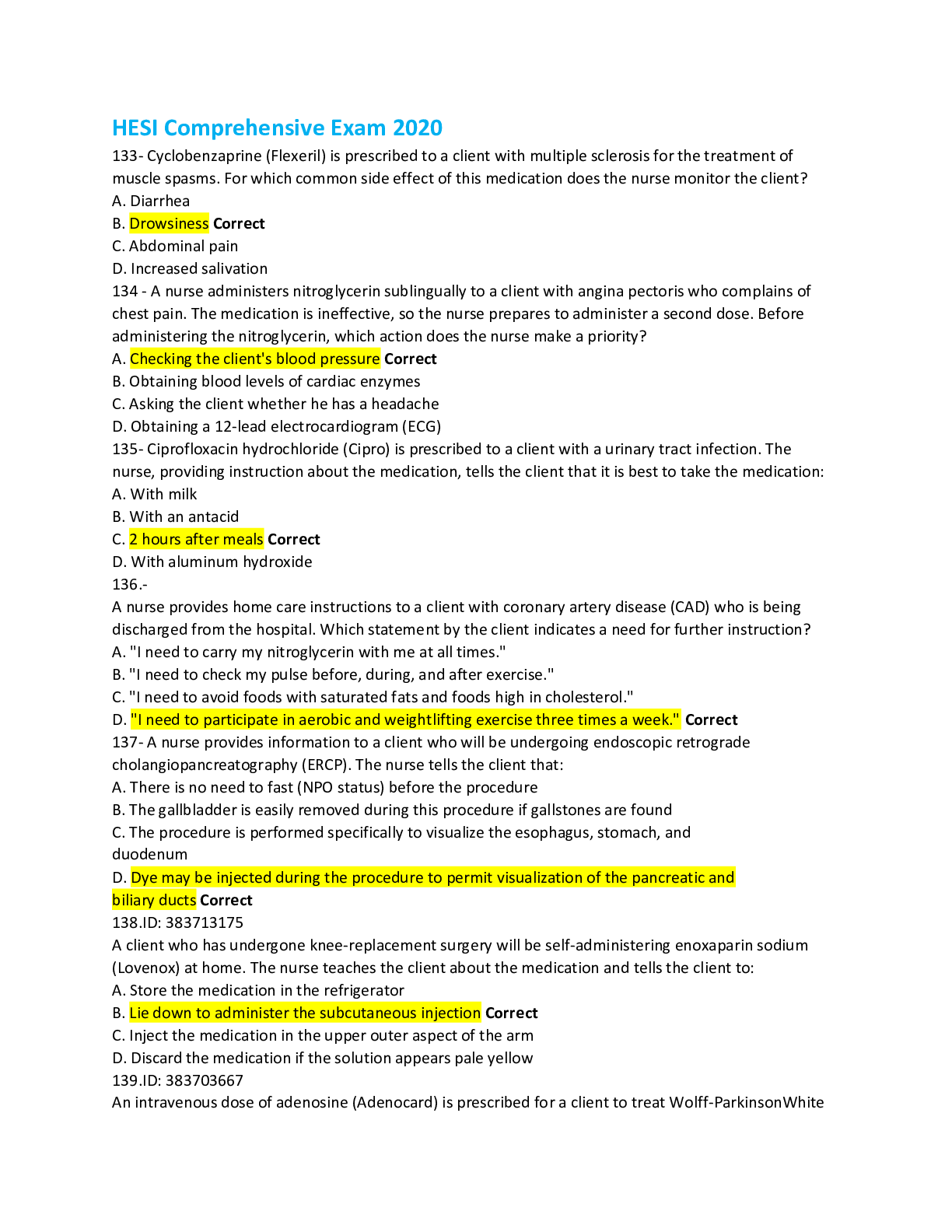
Buy this document to get the full access instantly
Instant Download Access after purchase
Buy NowInstant download
We Accept:

Reviews( 0 )
$10.00
Can't find what you want? Try our AI powered Search
Document information
Connected school, study & course
About the document
Uploaded On
Dec 02, 2020
Number of pages
24
Written in
Additional information
This document has been written for:
Uploaded
Dec 02, 2020
Downloads
1
Views
229

